 8Likes 8Likes
 |
|

8 Nov 2012
|
|
Registered Users
Veteran HUBBer
|
|
Join Date: Dec 2009
Location: Bucharest
Posts: 118
|
|
Between the past and the present: 19-22 October
We are still far away from the border but we feel we are getting closer. The easiest (fastest) way would have been to continue on the Pacific coast to Guatemala. As we weren’t in a hurry we decided to head north first, entering the old Mayan empire territory.
We still have to ride for a while to get there. On some paved roads…

…and on others less paved

And the only constant is the temperature…. a high temperature. No wonder everyone is trying to cool off the best they can. And at noon, it is siesta time…

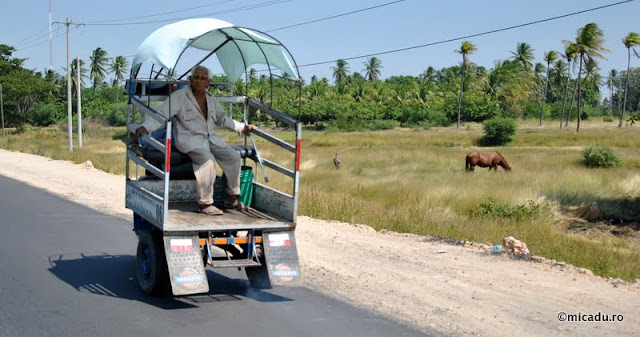
We manage to refrain ourselves from turning right on one of those small roads that seem to lead on a deserted beach. Maybe we should have done it, we weren’t in a hurry. We get on top of a hill and we can see in the distance endless beaches tucked in between thick vegetation and the blue waters of the ocean.
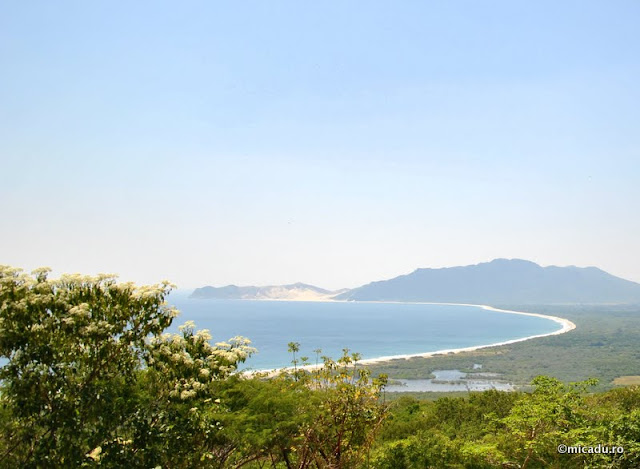
We admire the ocean one last time (in Mexico) and head to the green mountains. We are developing a new traveling rhythm but we still have to learn how to properly relax. This time we avoided the beaches because we had no cash and decided to look for an ATM first. Ah, what a “pragmatic” excuse. We have no time to regret the beaches left behind though as we get to enjoy the beauty ahead.

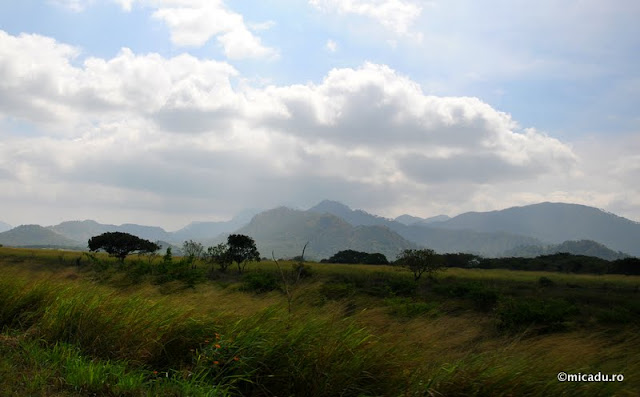
And the road wants to keep up with the scenery as well. Good pavement, well marked, going up in the mountains. Sometimes having a tall vegetation green wall on both sides and sometimes steep cliffs on one side.
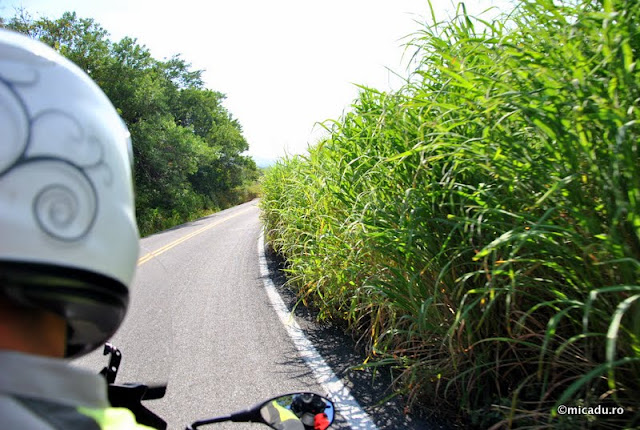
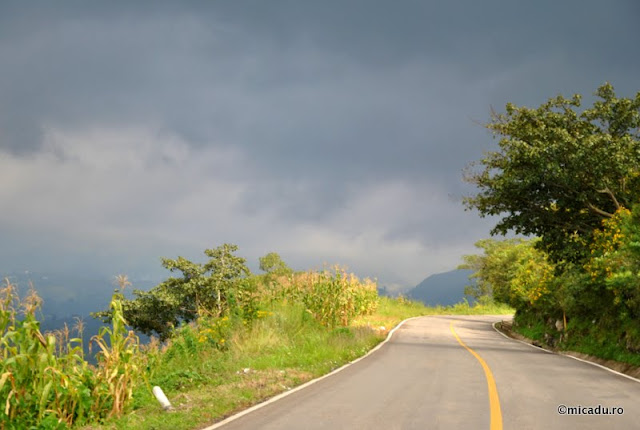
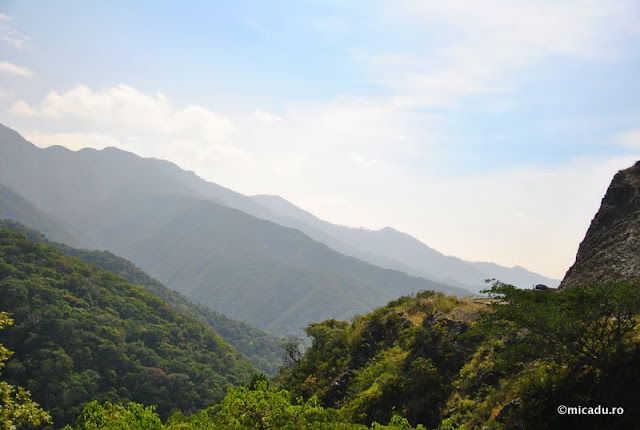
We are then reminded that human footprint on the lands is not always a positive one.
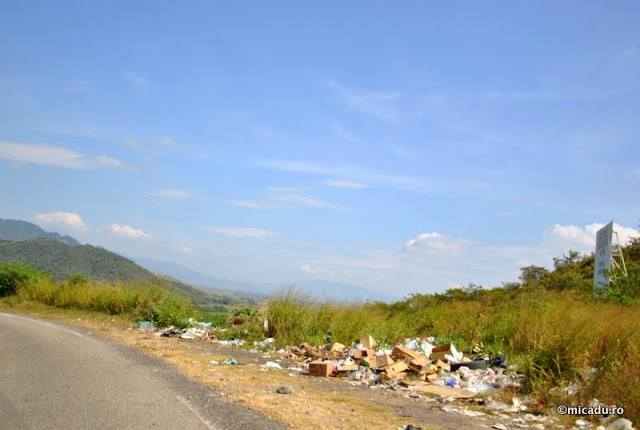
Garbage has a strong impact in these places where nature has so much to offer. But who is to blame? People from here who produce trash and throw it in the nature or maybe the companies that commercially invaded their lives, selling them things they didn’t need, without offering them an efficient method to get rid of the trash? It’s an endless debate but a real problem that should be looked into from both sides.
And ironic enough, just a few meters down the road, we see the government solution for the situation: “Let’s scare them with big fines”!

So if you throw away trash you get fined, a 90 minimum salaries fee. That’s great, but I seriously doubt that this is really enforced or that it could be enforced for that matter (who would have here the actual money to pay such a fine?) And if they are not affected by it, they don’t really care about it.
These people live a harsh life, from another time, somehow forgotten by the new “always on the run” society living in the “civilized” cities. So it might be easy to judge but it might be rush and even useless.
There are no supermarkets here. There are no malls or other useful places where you can buy the “strict necessities” in life. But you can buy boiled or fried corn, right from the side of the road.
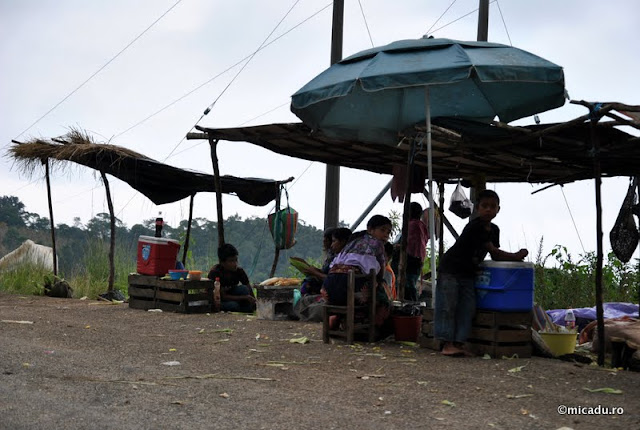
And how about walking all day long carrying with your head a load sometimes equal with your own weight? Would you still be willing to go to the next trash bin to throw our garbage?

Oh… and I forgot to mention, the nearest trash bin is… uhmm probably miles away!

We reach the village, more than 2600 meters altitude and we have a look around.
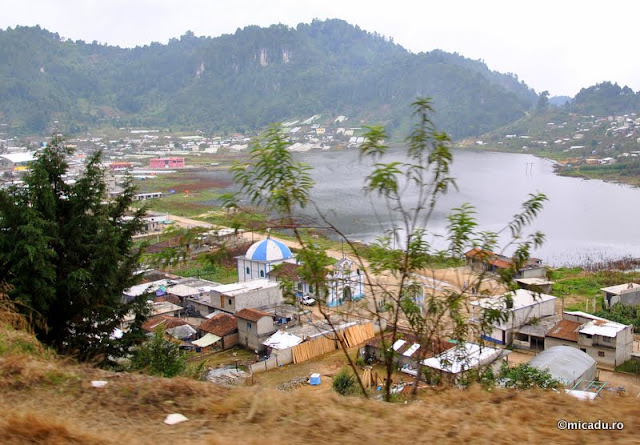
There are no big commercial establishments but this doesn’t mean that there is no capitalist life of unstoppable consumerism. Of course this Mayan descendants need Coca Cola on a daily basis as well as many other plastic wrapped products. Plastic that ends up on the streets where ironically puddles mirror the beautiful traditional costumes worn by girls and ladies.
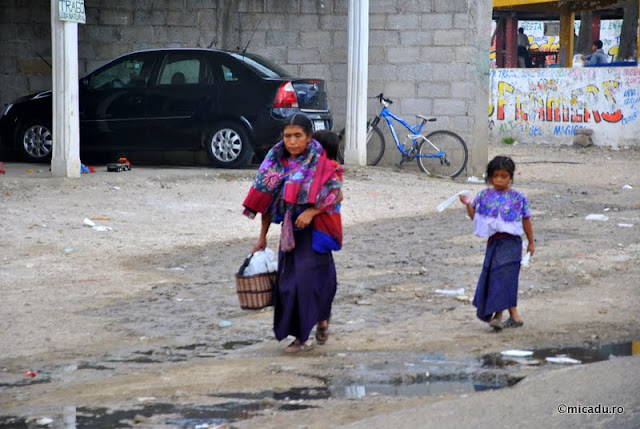
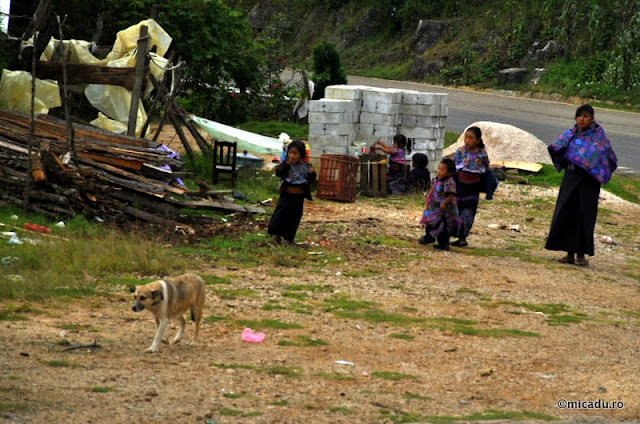
And even here, in the isolated village, one can connect to the wonders of internet. We wouldn’t want a day to pass without Facebook (and yes, that’s self irony).

But people adapt to always changing reality, combining -sometimes in a pleasant, sometimes in a weird manner- the traditional past with present of jeans and printed T-shirts.

Most of the people wave back as we wave them. But some are not shy to show their despise towards (what they think) we represent. If only it would be just that -a calculated and conscious response- and not just a lack of good education and lots of stupidity…

But who knows? We continue onwards through people animals and corn fields.

Bare feet on a roll of barbwire. When us, the grownups, forget, children can remind us, even just symbolically, that we can and we should overcome artificial barriers. We don’t know who this girl is but we will take this image with us…

The last place in Mexico we wanted to stop for a while was Palenque, an old Mayan city, now an archaeological site that can be visited. The narrow road winds its way restlessly, descending from the mountains and getting deeper and deeper into the jungle. Vegetation changes again.


And as we were riding and enjoying the views we were forced to sudden stop. In front of us a group of people was blocking the road. Some people were skillfully manipulating 2 wooden boards with nails that they were putting in the middle of the street. You had to stop, and then other gentlemen were approaching you and telling things and asking for money. I evaluate the situation and realize that the good thing is we are not alone on the road. There is a full bus in front of us, also stopped. And on the other side two cars are greeted the same way.
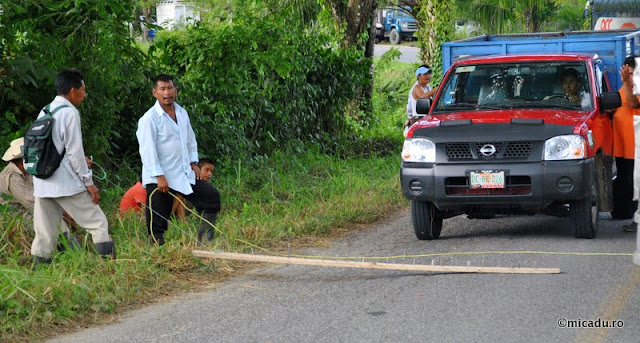
Still…. I don’t feel at ease. This is not right… Andreea becomes all quiet in the back. One of the “gentlemen” approaches us. He is holding a jar and asking for money. He is speaking pretty fast so I don’t really understand what he is asking money for. But I decide I don’t want to give him anything and I tell him that in Romanian. He doesn’t hear neither Spanish nor English so he gets confused but repeats his request one more time but less convinced. I repeat in Romanian that I don’t understand what he is saying, I am from Romania, I don’t know Spanish nor English and I don’t want to give him any money. Of course the man only hears some nonsense words and decides we are good to go. He leaves puzzled. The bus in front is allowed to pass and I try to take this opportunity when there is no board with nails on the road to cross also. It’s not working. The wooden board is pushed back on the road and I have to break fast. The guy manipulating the board seems starts to talk with your guy and luckily they decide that we are nice guys and we should be allowed to pass. We speed up and few meters away everything seems to go back to normal.
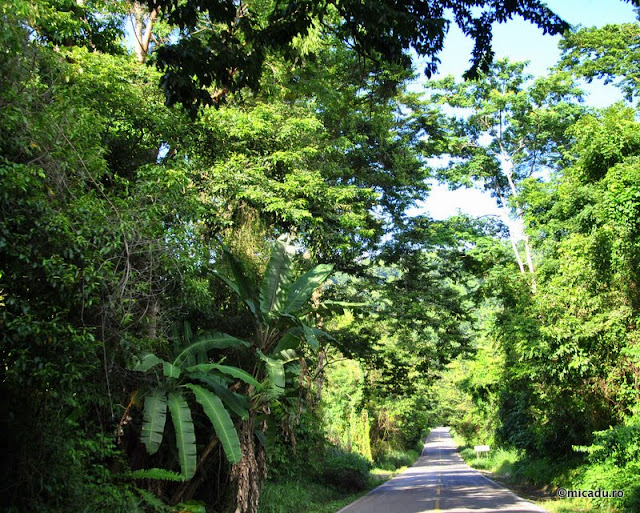
We are quiet, thinking about what happened. Definitely these people weren’t the “bad guys” from Mexico we were warned about. They were probably some people in the village in big trouble and needing some help. The wooden board with nails was just a brutal way of convincing the people always in a hurry to stop and listen to their problems. And help them with some money, of course. Maybe we got scared and we weren’t supposed to. These kind of actions are not rare in Mexico. Something similar happened to us in Oaxaca. Just that there were no nails on the road over there, just a human shield. The feeling of insecurity stays with us for a while. I guess you cannot feel otherwise when you are stopped by men with macetas, using boards with nails. A brand new VW Golf 5 driven by the man in a suit passed us. For sure he was stopped just like us. Now he was talking on the phone, relaxed. Nothing out of ordinary for him. What a difference. I keep thinking what would have been the reaction if something like this would have happened in Europe. Call the police, hand out fines, tv news crew, everything. Here, just another day. It was OK that we weren’t alone. We thank God we are alive and continue our journey to Palenque. We avoid the city and find a place to sleep in the jungle, in a bungalow, close to the Mayan ruins. There is an unbelievable noise outside, there are lots of birds and animals hidden in the dense vegetation. Like in a movies I was watching as a kid.
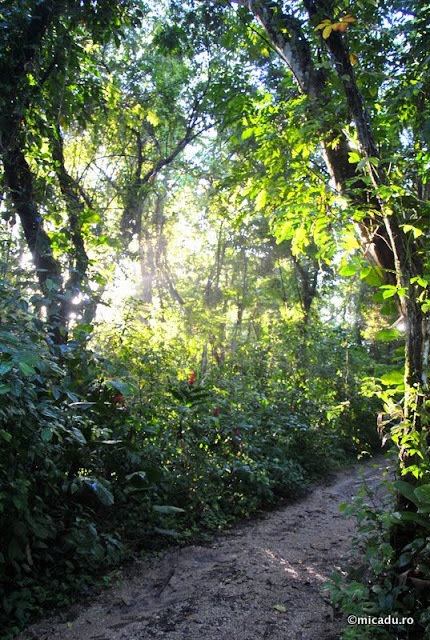
I park the motorcycle in the howling of the monkeys and call an end to a too long day.
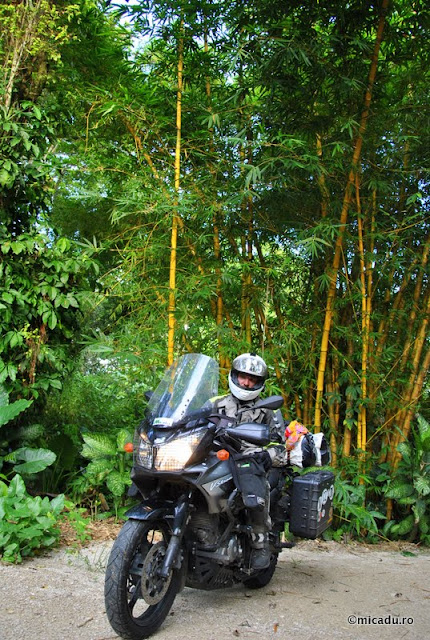

We go to bed after Andreea gets rid of a big spider hanging above our bed. Hmmm I thought we are sleeping in a bungalow and not in a hammock so that we could avoid such “creatures”. Never mind, all is good! The sleep comes with the the rain drops and a question: Will we exit Mexico tomorrow?
The map for this post:
 View Larger Map
Next time we try to exit Mexico and we find out that it is not that easy. Stay tuned!
View Larger Map
Next time we try to exit Mexico and we find out that it is not that easy. Stay tuned!
|

11 Nov 2012
|
|
Registered Users
Veteran HUBBer
|
|
Join Date: Sep 2008
Location: antigua,guatemala
Posts: 216
|
|
Great pics    , looking forward to see the ones from Guatemala .
Ride safe ,
Julio
|

15 Nov 2012
|
|
Registered Users
Veteran HUBBer
|
|
Join Date: Dec 2009
Location: Bucharest
Posts: 118
|
|
@GuateRider: hey Julio, I hear you are enjoying Mexico too! Have safe rides! We are really getting lazy with our progress. We just exited Guatemala yesterday... after 3 weeks spent there. Great times! Soon we will have to speed up for the boat.
But... here it is the story about how we entered Guatemala  In Guatemala: October 22-23
In Guatemala: October 22-23
This is it! After more than 3 weeks in Mexico and with the initial moto insurance running out 3 days ago, we felt that it was time to hit the road so we wake up in Palenque with the clear target: Guatemala!
From Palenque to Guatemala it is not very far. You need to reach a small town called Tenosique and then onwards to El Ceibo a relatively new border crossing that is not very well known nor it is very used.
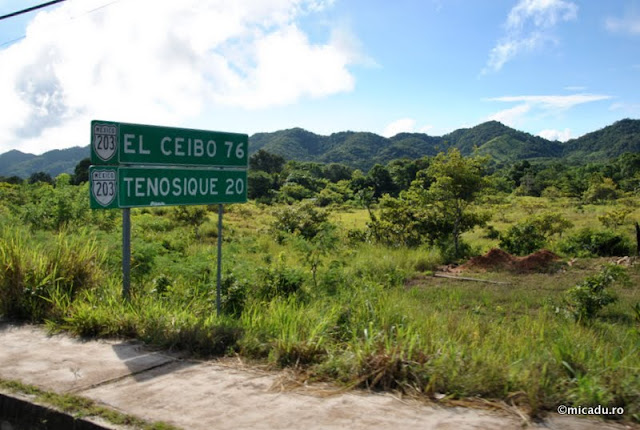 We found out about it from Alex si Dagmar, our friends from Mexico City. But the funny thing was that when trying to find more details about it while on the road we were getting very diverse answers. First of all it does not exist on our Mexico GPS map or Paper Map. Also Google Maps doesn’t know it. And when we were asking people around Palenque we were getting answers ranging from “There is no road that goes there, only a boat crossing” to “there is a road but it is in a very bad condition, you have to cross a river and then you are on the Guatemalan side. Passing over the mere existence of the place (of which we knew from Alex and Dagmar but we just could not pin point it’s location) we had another problem: when entering Mexico with a foreign vehicle you have to make a bank deposit (400 dollars in our case) that you get back when you exit your vehicle from Mexico. There is a separate entity dealing with this procedure called Banjercito. Apparently not all the border crossings have a Banjercito office so you cannot exit everywhere. Or you can do exit wherever you want and make a 400 dollars donation (your deposit) to the Mexican government. We learn from HUBB and AdvRider that there is a Banjercito in El Ceibo but it is closed on Monday. And today is…. Monday, exactly!  The post was from 2010 so maybe things have changed until now.
We decide to go to border and see if we get into Guatemala or not. We meet a few police and army checkpoints along the way. We ask about the Banjercito and they all confirm that there is one and it’s open. Let’s go then, maybe we can cross. Guatemala feels so close!
At one of the Mexican checkpoints we see the wooden board with nails again that brings us bad memories. So this “tool” is used by the army also, in emergency cases. Luckily it was just sitting there, on the side of the road.
The isolated and less known border crossing is almost deserted. We park in front of the frontier building and we are the only ones there. A man approaches us and tells us where to go. Ah, that’s good, it’s means we can cross today. We start preparing our documents when another man shows up and tells the first one: “Hombre, they cannot cross today, the Banjercito is closed”. Ah, we were so close! We take a sneak peak of Guatemala and promise to come back tomorrow. For now, Mexico, here we come! Again!
We go back 50 kilometers to Tenosique. At least the road is nice. Very nice.
After a few unsuccessful trials we find a hotel. It’s clean, it has internet and we have time to write another post for Micadu (probably one about Northern Mexico) and we wait for Tuesday to come….
Next day we go back to the border and everything goes well. Banjercito is open, we take care of the formalities for the motorcycle and then we get our exit stamps for Mexico on the passports. We are in “no man’s land” and head towards Guatemala.
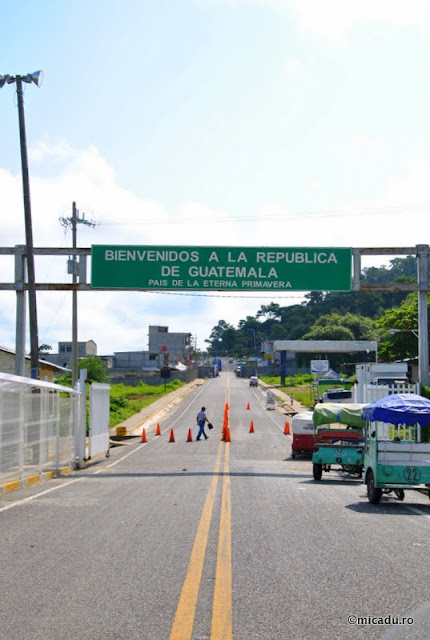
On the other side we park the motorcycle in front of the Guatemalan frontier building. We are the only foreigners there. Only locals seem to know about this border crossing. And because the border is isolated there is no commercial traffic. Perfect, no trucks! We hope to have an easy crossing. And since we are in another country, we take down the little Mexican flag that we received from Tom in Banamici. Two border guys notice what we are doing and ask us what’s with the flag. We tell them that we carry the Romanian flag and the flag of country we are passing through, if we have it. In Mexico we had this small one. Now we have to find one with Guatemala. The border guy smiles to us, he has an idea. He tells something really fast to his colleague and comes back with a Guatemalan flag as big as our panier. He even has scotch tape, so the two men immediately start working on our motorcycle.
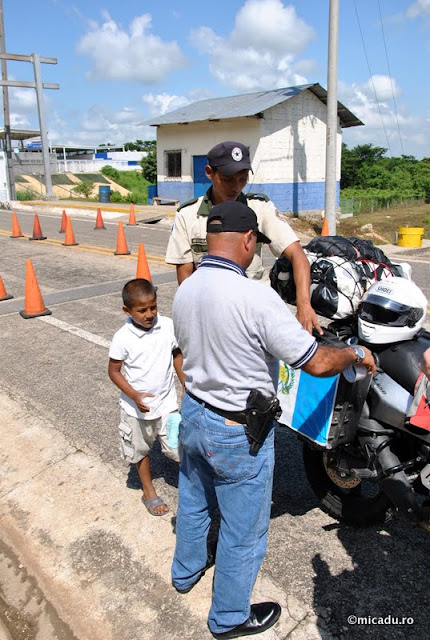
Andreea stays with the moto as I try to figure out the bureaucratic flow. First I need some stamps on our passports so we can be allowed in Guatemala. Meanwhile, at the motorcycle….
Then I have to go to another building and start the procedure for Gunnar’s temporary import in Guatemala.
Meanwhile, back at the motorcycle….

To finish the formalities I have to make some copies of the documents that they just issued. There is no copy machine at the border so I have to take a tuc-tuc (madly driven by a child) and go look for a copy machine in the nearby village.
Meanwhile, at the motorcycle…
I come back from the village with the copies and after I get some more stamps I have to go to a bank and pay some tax. You cannot pay with the credit card at the bank and I don’t have too many pesos left so it’s time to start looking for the dollars I kept well hidden “just in case”.
Meanwhile, at the motorcycle…
Basically, whenever I was going out of a building and running to the other one I was taking a look at Gunnar and saw that something else was going on there. But everything was OK and they were all respectful and nice with Andreea who got a cold drink and was invited to rest in the shadows. Meanwhile I was running around with documents from one office to the other. Oh well, everyone is having fun, their own way.
One hour and something later we are ready! I was reading all sort of unpleasant stories about border crossings in Central America. For us crossing into Guatemala was a real pleasure. Everyone was friendly and, being such a small border crossing, we ended up knowing everyone and everyone knew who we were and where we were going. We shake hands with the border men and they wish us safe travels in Guatemala. This is is! We are leaving!
We are in a less populated area. And full of contrasts. Normally we were supposed to be in a jungle, and the places where nature was on her own were luxuriant green.
But other places the jungle was just a memory:
Massive deforestations. Here you cannot say “you cannot see the forest from the trees”. No matter how hard we tried to imagine things were not how they were supposed to be. And we were to find out the next day about an old practice, thousands of years old. One that was probably the main cause for the decline of a civilization.
But before meeting the Mayan civilization from thousands of years ago we see the marks of a more recent one, from 2012.
A sad and strong contrast with the clean nature surrounding us.
We feel like we saw this before. We feel like this picture of trash thrown away all over the place is uselessly repeating. We promised ourselves before leaving that we will remember the world as it is. I don’t claim to be a photo-journalist but still I cannot only show the “beautiful” pictures, the ones that look good in the magazine. The New World is fascinating in all its forms.
We see the first settlements in Guatemala. We are in an area that was strongly affected by the Civil War that lasted over 30 years and ended not so long ago, in 1996. There are modest villages with barely no infrastructure, except the main road that passes them by.
Everything is closer to the ground. The ground that seems to be the main source for survival, ironically unsustainably used but many times strictly necessary on short term.
We pass the few villages we meet along the way and get closer to the place where we want to stop for the night. Lake Peten, in Northern part of Guatemala is famous for being one of the cores of Mayan civilization, the city of Tikal being probably one of the greatest ever built by the Mayans.We stop on Flores Island, a place that is mainly touristic. What a difference between the villages we just passed and this tourism oriented place.You can tell where you are from the marks left by the big commercial chains.
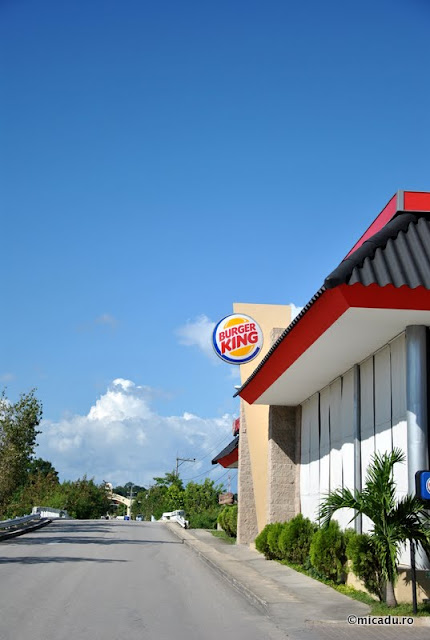
We barely find a hotel not made for foreign tourists (without North American price levels and not especting dollars instead of quetzals- nation currency of Guatemala). There is big bustle and the tuc-tucs are flying around carrying tourists and locals.
We manage to find a quiet place, park the motorcycle inside the hotel (again) and try to get used to the new location.
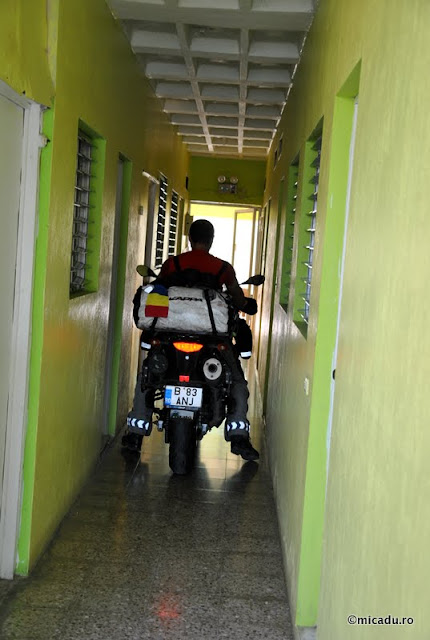
Today was a special day. The first day in a new country is a little bit weird, you are in between two different worlds, still trying to adjust to the new “rules”.
We enjoy the sunset over Lake Peten and our thoughts fly back to the last weeks.
We stayed in Mexico more than we hoped for and still, we feel that we could have stayed twice as much and still we couldn’t have discovered all that it has to show. We look back with joy and content to all that happened to us the past weeks. The frights of the first kilometers we rode in this country “feared” by so many people and the easy-hearted stops we take now anywhere to eat at the “comedors” by the side of the road. From the worried thoughts when we had a flat tire at 2500m in the middle of nowhere in the mountains to the relaxing days we spent by the ocean and the towns where we met such beautiful people. 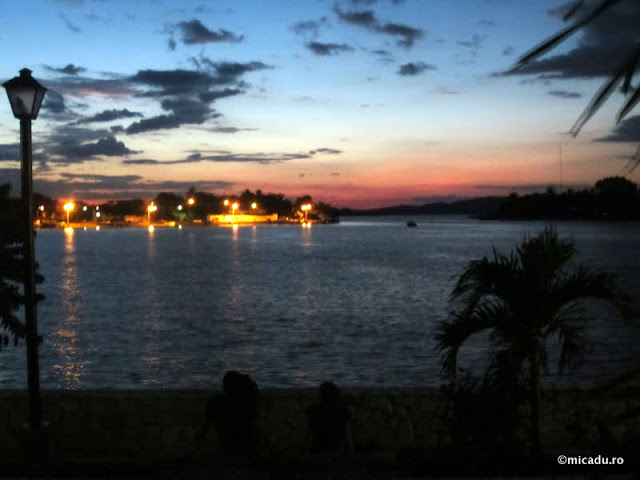 Mexico was supposed to be just a short chapter of our journey. A gate to Central America, a place that many people avoid and even more fear, a place we had to cross. It turned out to be more than this and we would love to go back. And now Guatemala! A country we barely new anything about before coming here. Over the lake, hidden in the dense jungle, there is Tikal, the old Mayan city full of mysteries and answers in the same time, echoing the life of an empire that flourished thousands of years ago, with scientific and technological performances hard to explain for those times and that suddenly disappeared without a clear cause.
 Wondering what we will see tomorrow? Stay tuned!
The road we took is not on Google Maps so the map for this post is shown on Google totally wrong. The route was Palenque-Tenosique-Flores, without the Southern detour.
View Larger Map
|

15 Nov 2012
|
|
Registered Users
HUBB regular
|
|
Join Date: Oct 2010
Location: Antigua, Guatemala
Posts: 64
|
|
Thanks for posting details on your crossing at El Ceibo. We've been getting lots of questions about it lately. I'll pass along your post to others, very helpful!
If you make it further south, stop in Antigua, Guatemala (definitely a popular spot to relax a few days) and visit us in Moto Cafe. Good to share some stories with fellow motorcyclists, join us for a ride, or just have a  !
Always great to meet other riders.
Moto Cafe
6a Calle Oriente #14
Antigua, Guatemala
14°33'19.50"N
90°43'52.43"W
Safe travels!
Chris
|

15 Nov 2012
|
|
Registered Users
Veteran HUBBer
|
|
Join Date: Dec 2009
Location: Bucharest
Posts: 118
|
|
Hi Chris!
I've posted a little bit more details about El Ceibo crossing here:
http://www.horizonsunlimited.com/hub...7-2#post397756
Hopefully it will be of some use to others that want to take that crossing. We can highly recommend it!
We would have loved to meet in Antigua, but sadly we already passed it. We are now in El Salvador, but the postings in the Ride Tale are way behind as writing is done only when we have internet and we can easily distracted by things like riding, nice beaches, surfing and other very "bad things" 
|

15 Nov 2012
|
|
Registered Users
HUBB regular
|
|
Join Date: Oct 2010
Location: Antigua, Guatemala
Posts: 64
|
|
Quote:
Originally Posted by AnjinSan

Hi Chris!
I've posted a little bit more details about El Ceibo crossing here:
http://www.horizonsunlimited.com/hub...7-2#post397756
Hopefully it will be of some use to others that want to take that crossing. We can highly recommend it!
We would have loved to meet in Antigua, but sadly we already passed it. We are now in El Salvador, but the postings in the Ride Tale are way behind as writing is done only when we have internet and we can easily distracted by things like riding, nice beaches, surfing and other very "bad things"  |
No worries, safe travels and keep up the adventures! Thanks for passing along the link.
|

19 Nov 2012
|
|
Registered Users
Veteran HUBBer
|
|
Join Date: Dec 2009
Location: Bucharest
Posts: 118
|
|
Tikal: 24th of October
With the head on the window, I try to get some sleep. That is not going to well for me as the small bus is bouncing on the bumpy road. It is 5 AM and it is way to early for me.
But everybody does it. There are tens of hotels and hostels in Flores during season all of them full with tourists. And all of them go to visit Tikal. It is after all one of the biggest Mayan sites discovered and we thought we might as well “play tourist” for one day as well. So… here we are, in the small buss, with other 6 foreigners and a guide, on our way to an old Mayan city.

Now Tikal is a National Park in Guatemala. But it used to be a flourishing Mayan city, an epicenter of their civilization. At it’s peak, it is estimated that it had a population of over 100000 people living on a radius of more than 7 miles. Now the place is home of just a few archeologists and other researchers. Fortunately they do not wake up that early so the paths in the jungle are still silent.
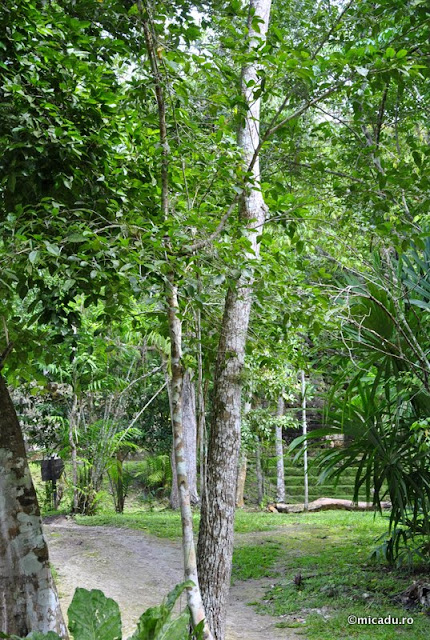
I haven’t seen the pyramids in Egypt. The Mayan ones appear to be generally smaller and they are solid, there are no inner chambers

And if the ones in Egypt are known to be tombs for the Pharaohs, the ones here served different purposes, they were ment to help men be closer to divinity by performing different religious ceremonies. The interesting thing is that while the Egyptians knew the concept of the wheel the Mayans did not. They knew how to make “round” things from stone (their altars are like this) but they did not used the wheel as a method of transport stuff. Then how did they managed with these huge blocks of stones? There are many theories (some of them involving Extra-terrestrial beings) but maybe a simple, albeit gloomy answer is much more “down to earth”: slaves. Many many slaves.

From our guide, Gonzales, we find out a lot of interesting details about the life back then. He speaks good English and he is not avoiding more sensible topics. Maybe now one can marvel at the architecture and ingenuity but the truth remains that on a lot of these temples there were human sacrifices. We can only imagine the priest climbing the stairs followed by the lucky person who was climbing them for the last time in his life.
The gloomy sky and the musky jungle add to the atmosphere that surrounds us. Beating hearts, taken from living bodies, bloody offerings to feared gods.
But who were these humans that started such a complex civilization? The research suggests that they actually came from Asia, crossing the frozen Bering Straight, then starting a journey South to Central America. We continue our walk, and we reach the central plaza. We observe a field where they used to play a ball game. The purpose could be differ (there were several games played) but the win prize was the honor of being sacrificed. Yeap, so the winning guys found their way up a pyramid and their slash! Uhh, that is a game that it might be better to lose… It is difficult to understand all the details of the life back then. To me it was a strange combination. A society so advanced (written alphabet, math, astronomy, culture, art, buildings) and yet so entrenched in mystical believes and violent practices of them. Later on, Europe, with it’s Catholic Church, would burn on the rug a lot of it’s illuminated minds (philosophers, writers, mathematicians and so on) on the grounds of heresy, effectively delaying discoveries and technical advancements. Here, the “sicence” was somehow in symbiosis with a religion that was much more violent. The same thing was bound to repeat with the Spanish conquest of Americas and the arrival of the church on the other side of the Atlantic. Thousands of writings burned, objects and building destroyed and people killed in the name of a peaceful religion, a religion of love. 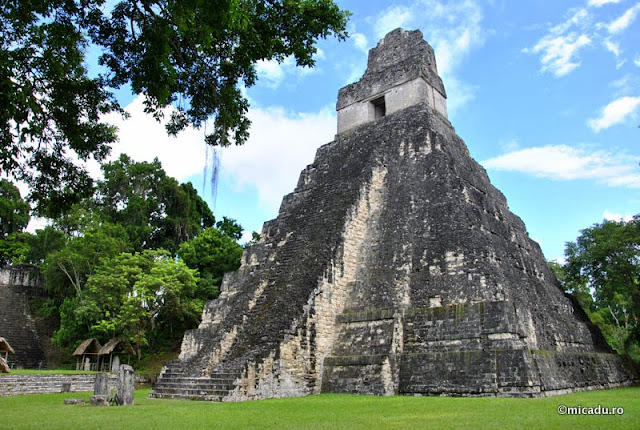 And yet, the actual reason of the fall of the Mayans is unclear. When the Spanish came, the Mayans were already in decline. Entire cities, like Tikal, suddently were abandoned and were left empty. It is speculated that one of the main reasons for this was in fact… the heavy deforestation. The need for more agricultural space in order to feed an increasing population, the desire to build bigger and bigger buildings (the cement used was created involving a process that required burning huge amounts of wood), all of these led to cutting off a lot of the jungle. This in turn lead to irregular rains, which meant bad crops and also less drinking water. The funny thing was that just a few years after Tikal was abandoned, the jungle reclaimed it and covered most of the buildings. 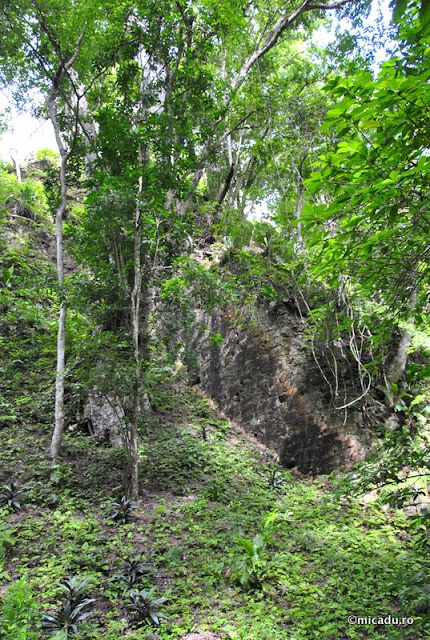  And so it is. The humans who conquered Americas, the nature and in the end time itself, destroyed a good part of what was once a great Civilization. The little that we know and see today, remains though utterly fascinating! All is tranquil now, but how was this place 1100 years ago? We can only imagine today. The jungle seems to know a lot but keeps it secretes well.
|

19 Nov 2012
|
|
Registered Users
HUBB regular
|
|
Join Date: Oct 2010
Location: Antigua, Guatemala
Posts: 64
|
|
If you're heading south from Tikal towards Rio Dulce, a really cool little detour is to check out Las Conchas - waterfalls, caves, hikes, eco-lodge. My friend has a place there, here's his website to get an idea:
Oasis Chiyu
If you go, tell Felipe that Moto Chris from Antigua sent you and he'll treat you well. One of my favorite spots in Guatemala. A few teaser pics:



|

19 Nov 2012
|
|
Registered Users
HUBB regular
|
|
Join Date: Apr 2011
Location: Yorkshire
Posts: 33
|
|
|
a great trip
How long are you travelling for? Great intersting trip so far, take care, and much luck with the rest of your travelling.
|

21 Nov 2012
|
|
Registered Users
Veteran HUBBer
|
|
Join Date: Dec 2009
Location: Bucharest
Posts: 118
|
|
Hey Chris, unfortunately we missed the waterfalls. But they look really nice. Well maybe next time (because I really hope this will not be our last time in Central America! these countries are so nice!)
Allchin: we've started on 10th of July from Montreal. We can hardly believe that it has been more than 4 months now... It is a dream. A very real one.
A lot of the first stories are on our blog ( Part I and Part II) as we've started to post here on HUBB only after we entered Mexico (thinking that for the majority of people here, North America is like the back yard so the stories wouldn't be so interesting...)
|

23 Nov 2012
|
|
Registered Users
Veteran HUBBer
|
|
Join Date: Dec 2009
Location: Bucharest
Posts: 118
|
|
The other Guatemala: 26-28 Octomber
Flores got us puzzled. Nature and its proximity to the impressive Mayan ruins made it a wonderful place but it’s hard to relax when you are welcomed and treated in the most touristy possible way. We could give many examples, unfortunately, but there is no use to mention them here. It’s enough to say that you need some time to get used to the fact that to many of the people there you are just a walking dollar. And once you realize this you can either get annoyed and start looking for “justice” that might be really hard to find anyway or enjoy the most you can under the given circumstances. I admit that I had a lot of “fun” all the time when at the same neighbourhood store and the same vendor, products had totally different price every time I stopped by. It’s a shame I couldn’t film the dialogues we had every time. The good part is that if you don’t get angry and are always relaxed when approaching them about it, the local “slicks” get pretty confused. It’s a shame that the location is so beautiful, a coquette island on an of lake that mirrors the jungle and sunsets…

And still, Guatemala cannot be only this. There must be something more beyond the “touristy places”. We feel we have to leave Flores and discover the Other Guatemala, one that gives us back a name and identity different than Benjamin Franklin. Therefore we plot a route that will take us South of the country, towards Course de Guatemala, Antigua and Lake Atitlan. Gunnar barely starts rolling and I sense us feeling better. After 3 days of sitting in one place, we missed being back in the saddle. On the side of the road the people are out working. Some cut the grass with their machetes…
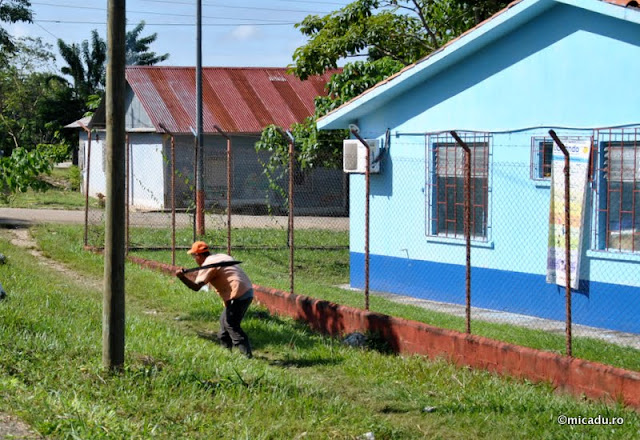
… some do their laundry.
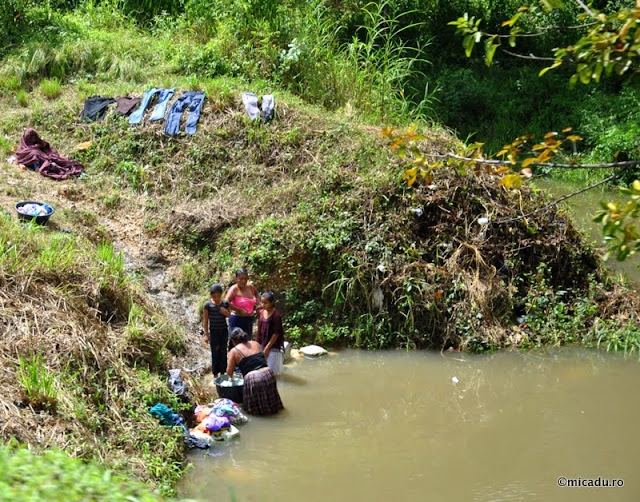
We reach Sayakche, where we have to take a “ferry” to cross the river. I think this is our second river crossing on this trip, after more the 30.000 km and 4 months into the trip

Luckily we get a spot on the first one, next to other local motorcycles. We have a few moments to relax and watch the way people live on both sides of the river.


It’s also interesting where they put the engines of our “ferry”: they are in 4 barrels strapped on the corners of the ferry. This way the engine can spin freely 180 degrees. Simple and ingenous.
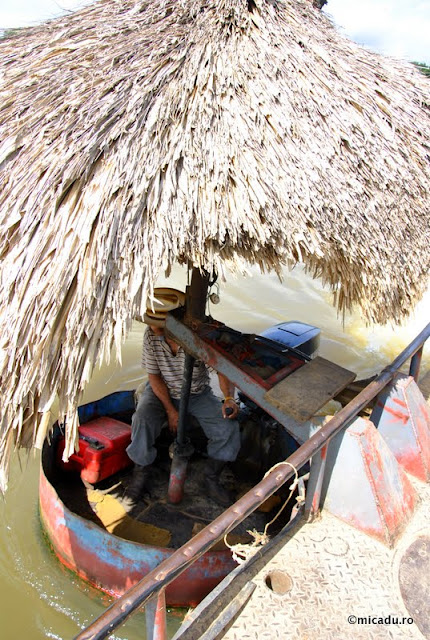
On the other side we are greeted by the mountains and a lot of green. What a beautiful day!
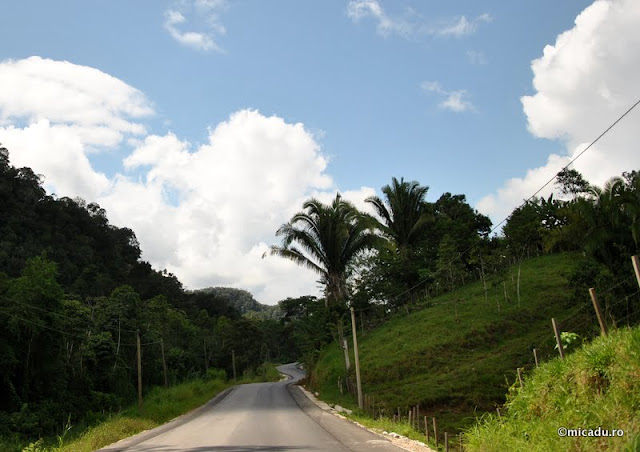

Guatemala is called “The country of eternal spring” and it’s not hard to figure out why. Everything around us is bright green! We notice something else: there are very few cars on this road, one of the main ones in Guatemala. And the few cars we meet are functional ones. Trucks and buses. No small vehicles. Here’s an example, “Rapido del Norte” speeding in the opposite direction.

We pass small cities and they are all the same: noisy, agitated and full of life. People going from one place to another.

You can find and you can buy everything on the side of the road. I feel like I landed in an oriental bazar.

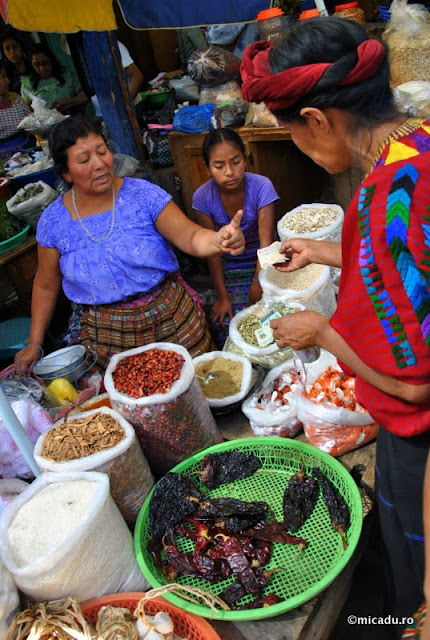
Everything calms down once we are out of the small cities. We meet fewer people, travellung by bus or by… foot.
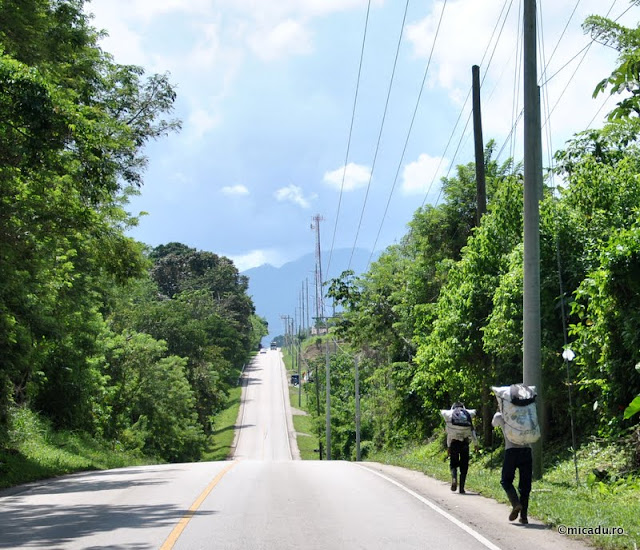
People, especially women, wear their traditional clothes. And they do it every day not just during the holidays. Statistics say that more than 40% of the population of Guatemala is Mayan, living in the hills and mountainous area and belonging to more tribes (over 15), each having their own dialect, costumes and traditions. A fascinating world. And somehow it doesn’t feel weird to see the beautiful girls carrying things on their heads, the way they do it for hundreds of years.
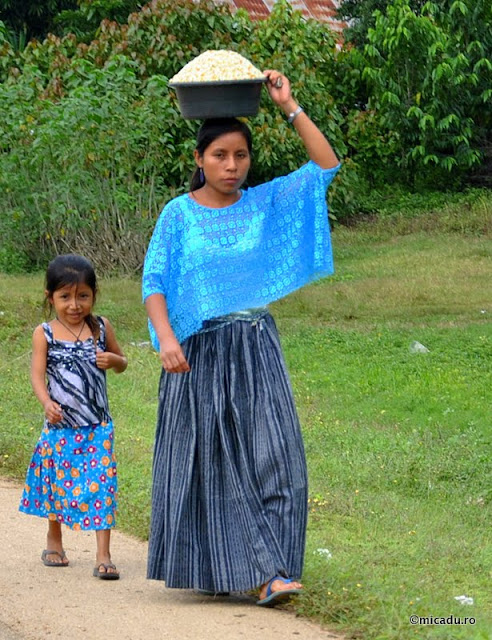
We stop on the side of the road to buy some oranges and we don’t feel the “mercantile pressure” anymore. Things seem to be normal here. We get our oranges that we pay with a few coins (probably the price for locals not for foreigners) and we get smiles also. It hard to tell though what’s behind those smiles. People here have been through a terrible civil war that ended not long ago. The war started in 1960 and ended in 1996 with a peace armistice that many considered a wonder. All this horrible war took place in these mountains that now seem so serene.
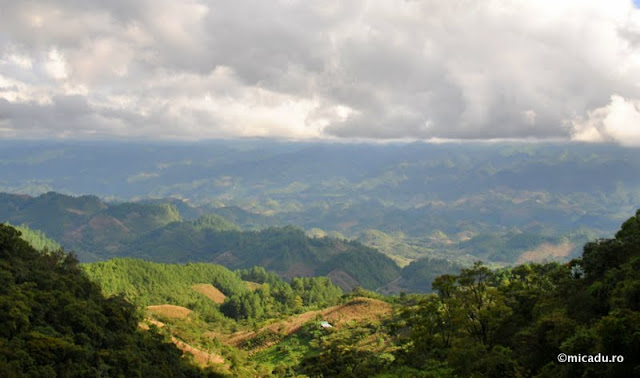
One of the reasons it started was due to big differences between the richness of the elite and the poor majority of the population, forced to work the lands that were no longer theirs but owned by the big corporations from other countries. The fight was tough and many innocent civilians were involved. Many of them are still trying to rebuild their life.
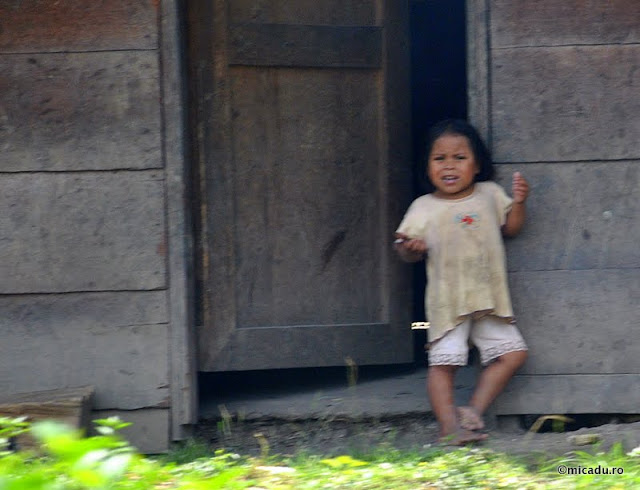
Just recently more information was reveled on the genocide committed by the government army troops (apparently more than 200 000 Mayans and peasants were killed) and on the involvement of foreign agencies (US) that were defending the interests of the corporations owning profitable businesses in Guatemala. For example, United Fruit Company- from US, of course- owned 42% of the Guatemalan land, that’s right, the fertile one, without paying any kind of tax for this thanks to the “settlement” made with the country’s “democratic” leaders. No wonder US was trying to keep unchanged the status quo of the matter opposing what they called a “communist” movement.
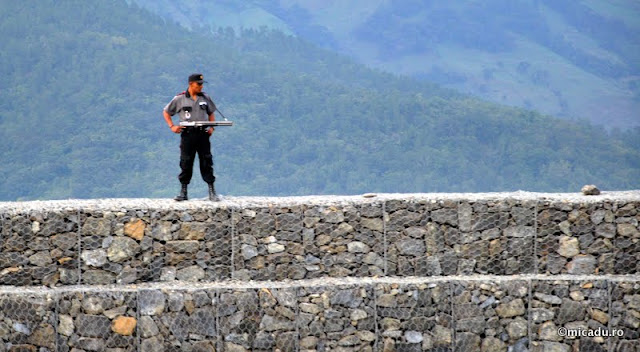
Things are not that simple, of course, there is never only black and white and what I wrote here are just a few pieces found out while travelling in Guatemala. But for sure many of the things that happened made no sense and should not have taken place. 36 years of blind fight, years of hardship for most of the population, forced to live in a country trapped between an ugly past and a never coming future. If you have some time it is worth to learn more about these events. They are unfortunately more actual that we would like. Just change some of the actors and… but I digress!
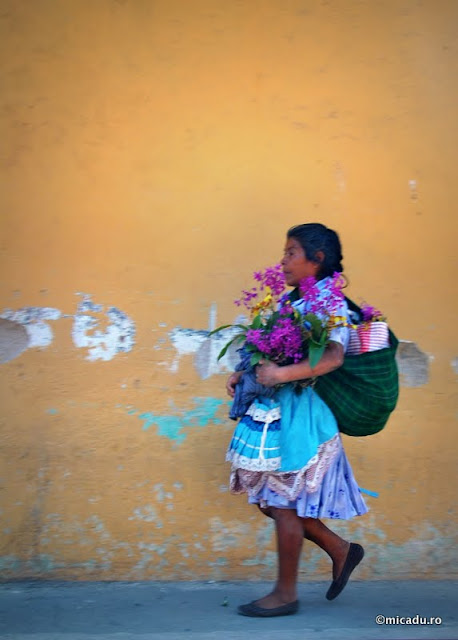
I would like to have the same approach as some of the people I’ve talked to on this topic. I noticed not only the reluctance to talk about what happened but also optimism and pride about what will happen from now on. They might be coming from a dark place but more important is that it’s all clear now. Now they can rest peacefully looking towards a future where they hope the sun will rise.
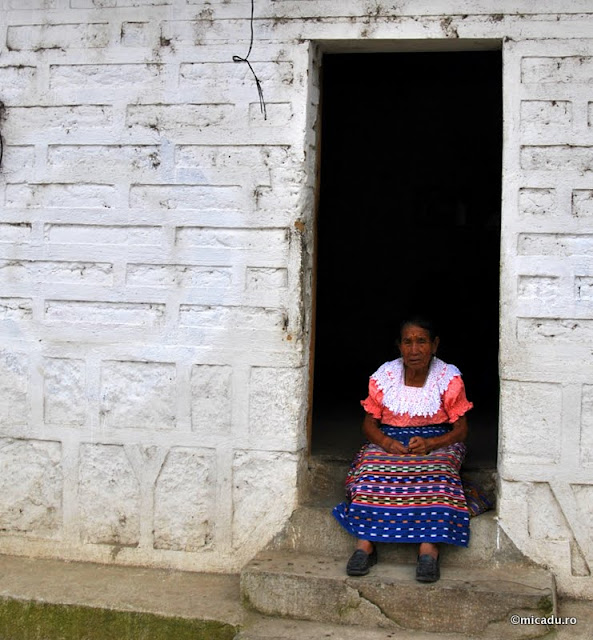
This seemed to me a healthy attitude. Maybe more spread among the older ones while the young ones have a “hot blood”. But I think sometimes is better to channel your energy on what you cn do from now on.
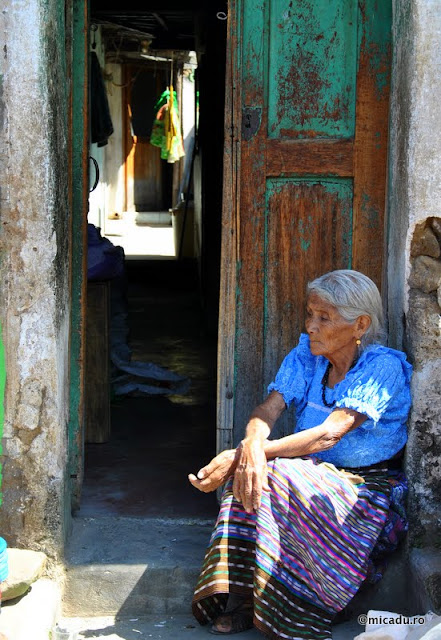
We were glad the ugly times seem to have came to past and today two Romanian travellers can freely discover Guatemala.
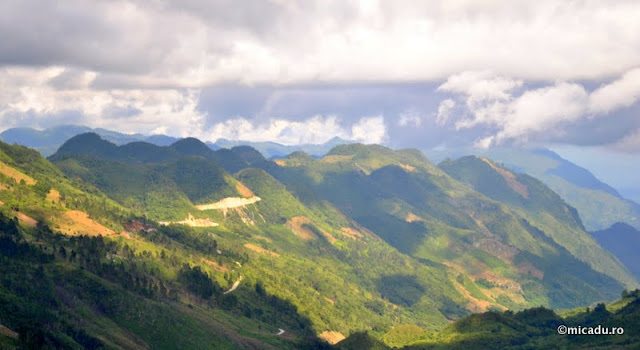
And children are now busy handling kites instead of guns.
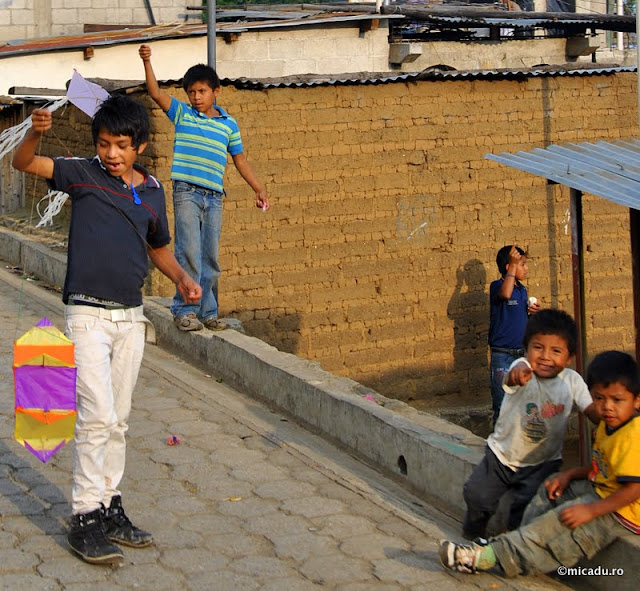
As for us, we enjoyed discovering Guatemala day by day, “the other Guatemala” where it is easier to interact with the locals based on honesty and not on a currency. Whether it is dollar or something else.
We spent lazy afternoons in old Antigua,
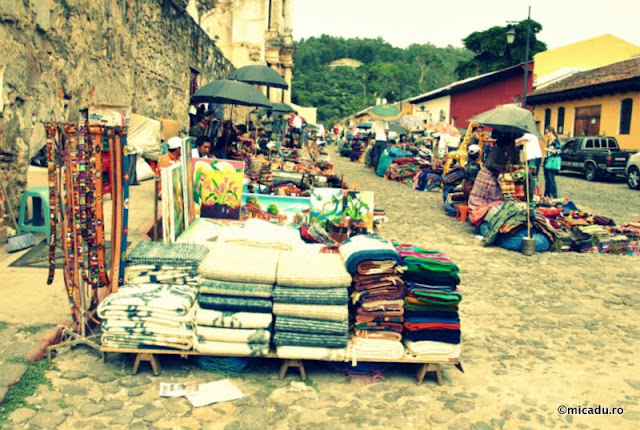
eating chocolate in the same room it has been produced.

Then we went to San Pedro la Laguna, a village set between Lake Atitlan and San Pedro volcano, “racing” (and losing) with the famous “Chicken buses” (old American school buses, now transformed into commuting buses).

And to get to San Pedro we left behind the 4 lanes intercontinental road for more narrow roads that lost their pavement at a certain point but not the traffic, heavy one, from the opposite direction…
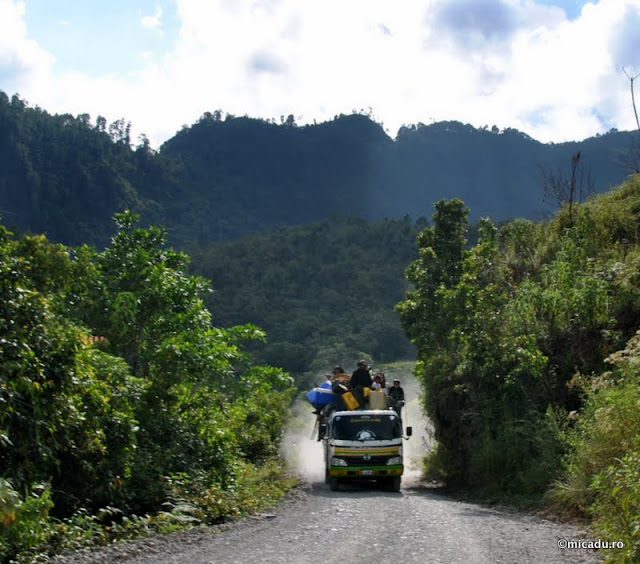
Or… coming the same way as us…
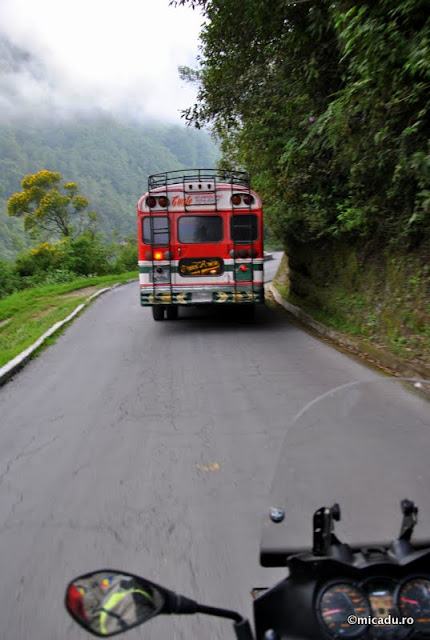
hmm should we try to pass? Luckily we are on a motorcycle and we can squeeze through!
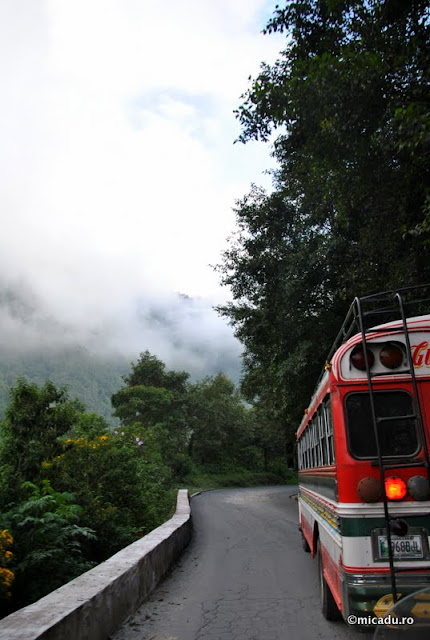
But its worth it to pass the big bus. The landscape just opens up and we have a great view on Lake Atitlan, guarded by a fortress of volcanoes. Wonderful!
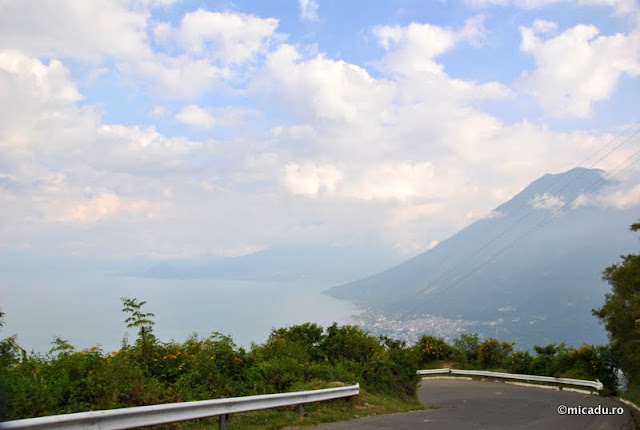
In San Pedro we found a place to stay towards the end of the village where we decided to spend a week. Our own bungalow with a hammock, view of the volcano and beautiful garden. Yeah, it is time to spend more time in one place.
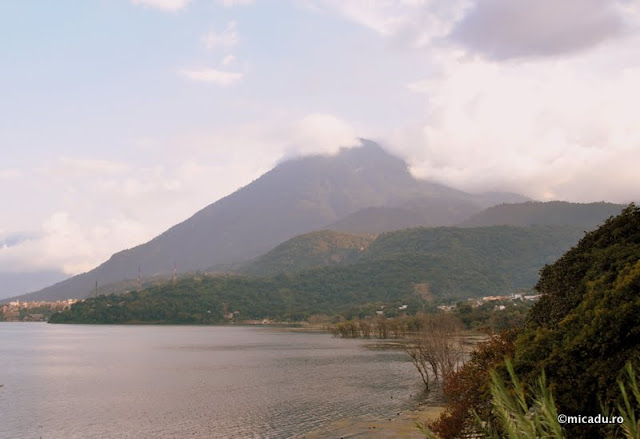
It was end of October and we found out that the first available boat to cross the Darien Gap was only on the 8th of December. Late… very late but we couldn’t find a spot for Gunnar earlier. We book the 8th of December.
This means we will have a whole month, November, to explore Central America.
But this also means that we will have less time to reach the South of Argentina, in Ushuaia, if we want to get there before winter.
And this also means that our plan to get back home on the 4th of February is no longer feasable. With God’s help, our trip will take more than 7 months.
And a new thought starts to take shape. What if Ushuaia is not our last stop? Can’t we just go further? Hmmmm…
Here’s the route map for this post:
View Larger Map
Next time we meet old friends and try to solve a very “serious” issue: where to find a quiet place by the ocean to spend a few days out of the remaining ones until the 8th of December? Stay stunned!
|

23 Nov 2012
|
|
Registered Users
Veteran HUBBer
|
|
Join Date: Sep 2008
Location: antigua,guatemala
Posts: 216
|
|
Hola Alex ,
good to see that you enjoyed my country and great pictures as usual   
But please take a history lesson before you start writing so much romantic bullshit about our recent history !!!
It was never a civil war , it was officially declared as a "Conflicto interno armado " , an intern armed dispute . Why that ? Because the civilian population was never more then an innocent victim and bystander .
No doubt about that atrocities have been committed on BOTH sides, but let's get one fact straight : Violence was started by the terrorist criminals from the guerrilla, while the army had the constitutional obligation to defend our national territory .
The terrorist were trained and equipped by foreign countries, two of the most bloody dictatorships of modern history : Sovjet Union and Cuba .
Being from Romania you should know what the USSR has been doing to small countries all over the world .
Unlike in other countries, in Guatemala the civilian population took never part in the armed dispute , they just ended up in the line of fire between the terrorists and the army . If they sold food to one of the two parties involved, then later on the other one would come and retaliate for the alleged alliance with the enemy ...
A lot of innocent civilians had to leave their villages and hide in the mountains, or leave the country . All those astronomical numbers of alleged victims are not documented and made up by one part of the so called international community, a bunch of overpaid burocrats who make a good living from the human suffering all over the third world .
I have personally witnessed atrocities committed by the terrorists, I had good friends tortured and killed by the terrorists . They kidnapped and killed several ambassadors (Germany, US) they kidnapped many good hardworking Guatemalans for randsom , they killed journalists,...
It was not a Robin Hood story, the poor against the rich . We were just unfortunate enough to be located in a strategically interesting position for the communist super power of that time .
Once again , I do not deny that atrocities and crimes have been committed on BOTH sides , I do not defend or excuse everything the US has done in my country .
But it just makes me sick to the bones when people omite to see that all this was started and provocate by the terrorists and not by the army.
Without our army defending our constitution and territory , Guatemala might have become another Nicaragua, a country that has been ruined and that is still run by a criminal dictator .
I know that you are genuinely interested in our history, so do yourself a favor and research on both sides . I would be more then happy to suggest you a few books, written by Guatemalans , about the origin , causes etc. of our internal armed dispute .
I hope I didn't get to emotional about this , but it is a very sensitive issue to me.
Keep on enjoying your journey and keep the great pictures coming !
Julio
|

24 Nov 2012
|
|
Registered Users
Veteran HUBBer
|
|
Join Date: Dec 2009
Location: Bucharest
Posts: 118
|
|
|
Hey Julio,
I think it goes without saying that I am not by any length a specialist at this matter. What I wrote was just a result of stories that I've been told by local people that we've talked with in Flores and then in San Pedro and I think in both cases the people were "normal" (not involved on any side). That's why I was also saying that further reading should be done and is quite interesting.
In the end, it holds no title of authority of the matter, it just depicts an example of the image that the conflict has for the "outsiders" (like me). And it is up to the Guatemalans how they want that image to be.
That's why it was very interesting to me to read your post (and it is normal to be an emotional involvement as you were part of it all) so I would like to know more. If you have any links with further readings, that you consider pertinent, I would be interested.
I never wanted to imply that only one of the sides did bad things. My story was intended to reflect the effects that the war (or internal struggle) had on normal people (on both sides). Do be honest I do not care that much about "hard core" aspects of any sides. "Communism" or "democratic capitalism" or any other "paradigm" taken to its extremes will only create monsters, one more uglier than the other.
I tend to stay out of politics and just try to understand the reasoning behind some actions. And these are rarely the official ones. Or better said, almost all the time there is something more than the official story.
Last edited by AnjinSan; 24 Nov 2012 at 18:09.
|

26 Nov 2012
|
|
Registered Users
Veteran HUBBer
|
|
Join Date: Dec 2009
Location: Bucharest
Posts: 118
|
|
Goodbye Guatemala: October 28 – November 13
San Pedro la Laguna is one of the many villages, smaller or larger, on the shores of Lake Atitlan. We stopped there for a week, we decided that it is a good place to wait for a new motorcycle chain and sprockets that were supposed to arrive via courier from the States. And indeed what a setting! The lake, the deepest one in Central America, is basically guarded by volcanoes!

A bungalow outside the city center of the village, in a quiet area with a view of the above mountain and close to the lake makes life switch gears and slow down in the heat of the dry season debut. Days go by slowly and lazy. Our main occupation is walking the narrow streets, going to the market and learning a little bit of Spanish (good opportunity to learn more interesting things about Guatemala from my Mayan teacher). After my previous posting, Julio, a Guatemalan friend, drew my attention that I might have a too romantic image of the internal war that Guatemala struggled with for 36 years. Maybe he is right, maybe it is easy to get an incomplete picture when you look at things from the outside. But I don’t think there is anything romantic about armed conflicts. And I confess war is one of the things I fear the most. Apart from “who started” and “who was right” there will always remain the horrible actions taken by both parties. I think that now it is more important that Guatemala is moving forward and leave all this behind. I hope from all my heart that they will succeed and we are happy to see places, like Lake Atitlan, which was a scene of the conflict, are now calm, quiet and inviting for tourists to take a walk to discover the details hidden on the narrow streets.

And the small village is full of bright colored surprises. For instance, the 3 wheeled Tuc- Tucs, used as taxis. Normally they are red-white and look like this:
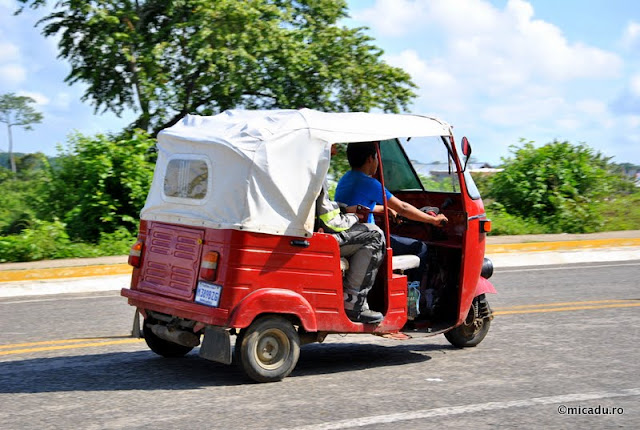
But who says you need a super expensive car to tune it properly? Here’s a real work of art, way above the tuned Romanian cars.
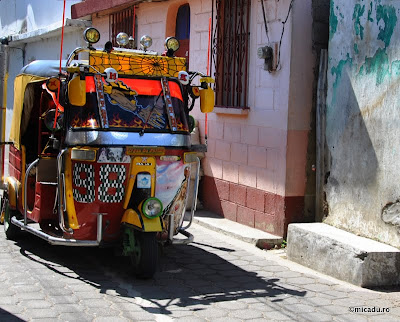
Well, if you really want to go for a ride in a tuc- tuc, at least do it with a properly pimped one! We didn’t go for a ride with it, probability the guy was really popular and had lots of orders. We prefer walking anyway when we are not on the motorcycle. And when you are walking you notice more details that you wouldn’t have seen otherwise.
 Working hands!
 I am dizzy! There is too much people here!
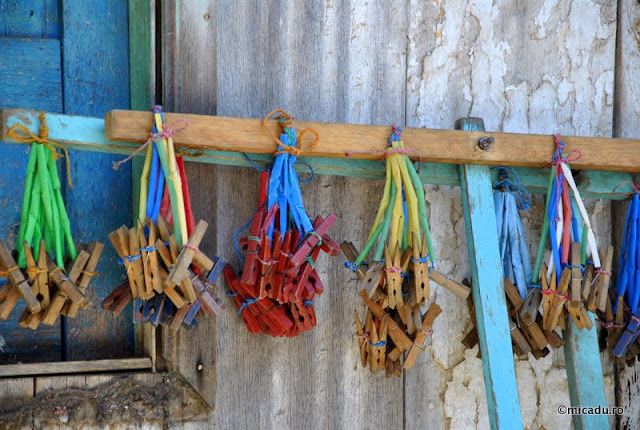 You only do the laundry in the family!
Do you remember our Vancouver visit when we spent a few days with Mihaela and Traian? And there was a car in their back yard ready to go to South America also? Well, the guys kept their promise and one of the days we were in San Pedro they showed up! 4×4 and same passion for long travels! Now that’s one tricked up car! They even have a tent on the roof that can unfold right there, high and mighty!

And because world is not that big, we meet Bogdan just like that, on the street, another Romanian traveling the opposite direction, backpacking from South to North. Only from one bus to the other, and more flexible than all of us, no car, no motorcycle to worry about. The next few days… San Pedro was now speaking Romanian. What were the chances for 5 Romanian travelers to meet in a small village in Guatemala? We were happy and spend a lot of hours talking…
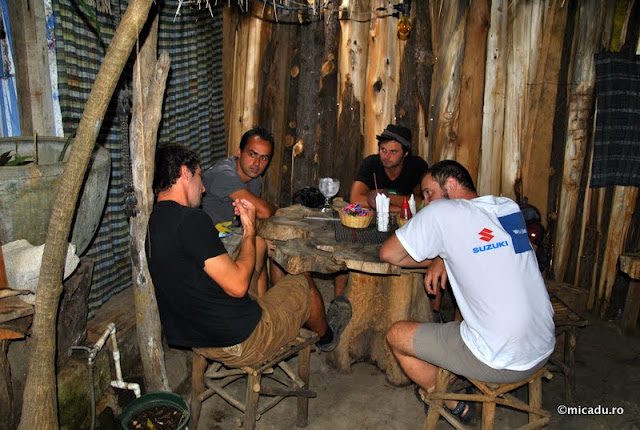
We say “goodbye” to the guys. Bogdan was going up North, as last part of his journey and Traian and Razvan had to hurry down South. They want to get to Ushuaia and back in 6 months. We shake hands and promise to meet again, if possible, somewhere in South America. As they come back up and we go down. Until then… safe trip, guys!

We stay some more in San Pedro and we are there when Guatemala, as well as many other Latin countries, celebrate Dia de los Muertos. There are interesting customs but we were intrigued by the high degree of mixture between the Mayan traditions and the “newer” rules brought in by the catholic religion. And indeed, many of the locals either Catholics or protestants kept their old traditions from one generation to the other.

The lake is a wonder also. It’s an endorheic volcanic lake with no link to the sea so water is not going anywhere. So when it rains a lot the water level increases significantly. That is why today many of the places that were once “by the lake” are now part of it.

Nothing was spared, old shops and hotels are now abandoned structures or in the best case, parking for the boats.
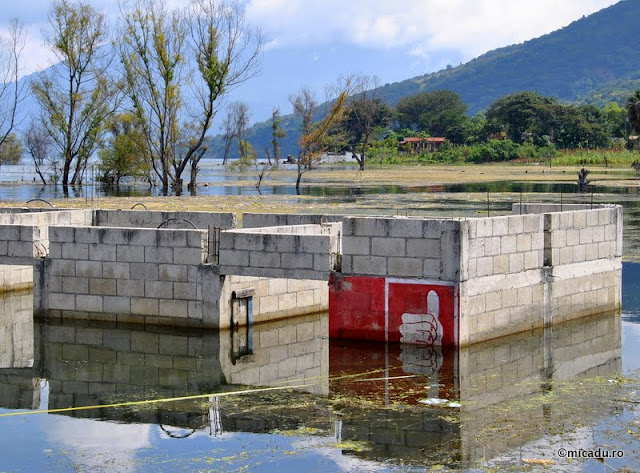

Internet you say? Sure we have, we even have wifi, right in the middle of the lake….
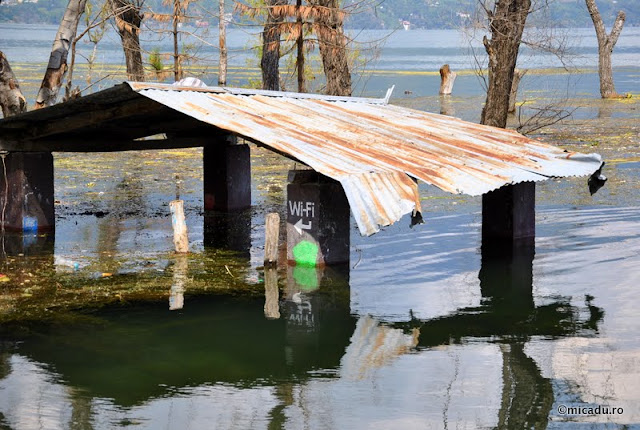
We take a boat for a short ride on the lake, to the neighbour village, Santiago Atitlan. The newly built deck sits above the old streets. We can see the old benches and fences under the water. It is a little bit strange.

Once we are on the boat we admire the landscape created by the lake and we understand why Atitlan is compared with Lake Como in Italy.
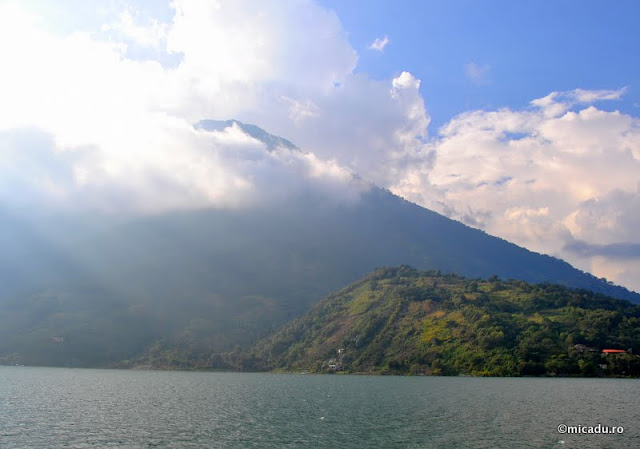
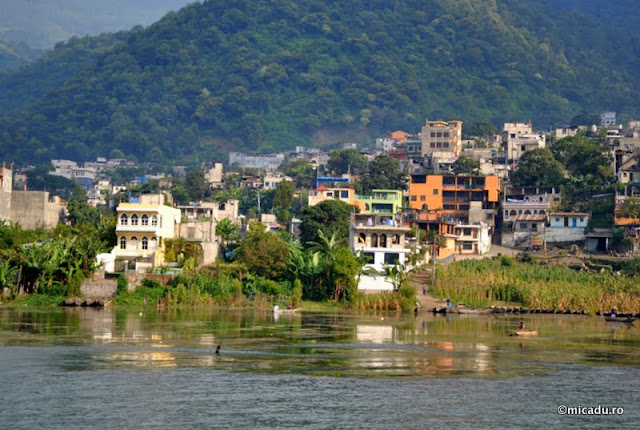
And maybe even better! As Lake Como is not surrounded by volcanoes like Lake Atitlan.


We think, though, that the lake is a little bit “overused”. There are many areas where water is really dirty. Lots of trash is thrown into the lake and for sure there are sewage systems from the villages that end up in the lake also.

And in the same lake women do their laundry or give the children a bath. Detergent, soap, shampoo, all into the lake (and the water of the lake is not going anywhere….).
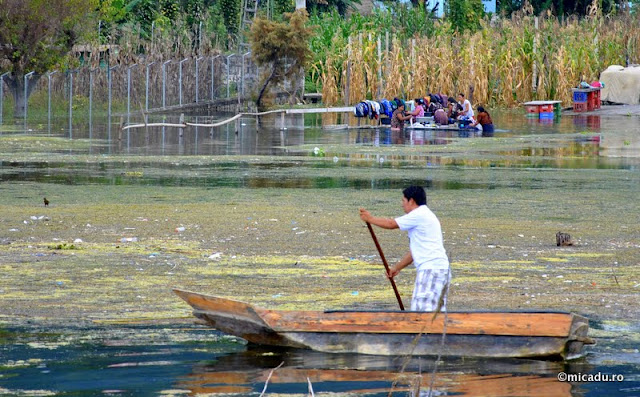

And day by day fishermen paddle their boats to catch some fish in the same lake. This makes a pretty picture if you take your mind off what’s in those waters.
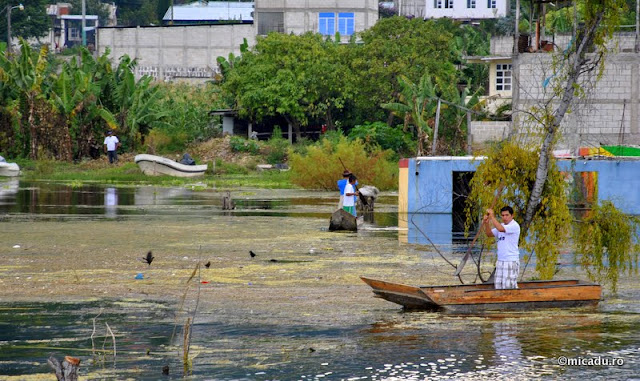
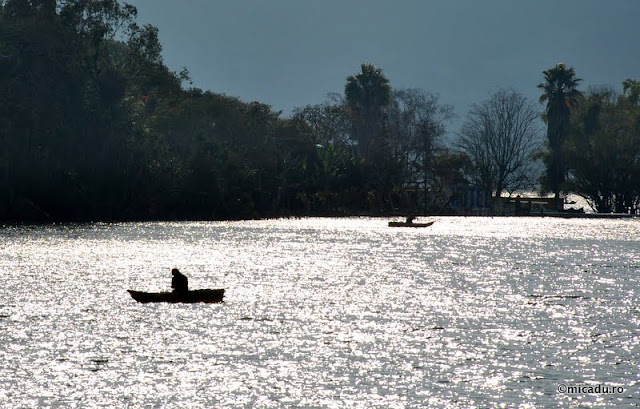
We leave San Pedro after a quiet and pleasant period we spent there. We considered ourselves lucky for being able to see the things behind the “touristic” curtain. Andres and his dog, Chato are waiting for us in Guatemala City, we are supposed to stay with them in the capital. We will also meet Richard there who is helping us with the spare parts for the motorcycle. We feel lucky again to meet people that we connect to on the spot. Not too many words, not too many explanations.
Andres and Richard prove to be extraordinary people. Without trying to flatter no one I confess that we spent more days than planned with Andres, because of his way of making people people feel welcomed. OK, I confess, it’s Chato’s “fault” also, for being the dog with the most “effiecient” puppy eyes I’ve ever seen.

Richard shows us the city and it’s surroundings and helps us with the spare parts we need. And when it’s time to go we accompanies us outside the city to make sure we don’t take the wrong road.

We leave Guatemala City – a city that many tourists avoid- with new friends, a very positive impression of the city and warm memories. We’re sorry that Luisa and Julio are not home yet to meet them too. But we are excited about their trip and wish them to get home safe, whenever that will be!
As for us…. we still have some time to spend in Central America, the boat that will take us from Panama to Columbia is leaving in a month. We don’t feel any pressure to leave Guatemala and as we like it here we decide to find a quiet place by the ocean to spend few more days. Richard told us about a place place like that. A small hostel, in a fishermen village, not yet on the touristic “radar” reachable only via a sandy road. That doesn’t sound to good for me, a beginner on a loaded motorcycle. But let’s try it.
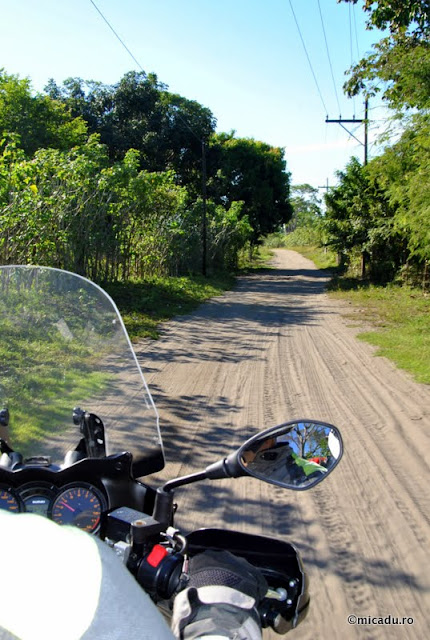
Doesn’t seem that bad. But from time to time there is someone strongly pulling my handlebars and the motorcycle becomes unstable. There are places where the sand gets deeper. Hmmm, this is not fun at all. We are not going that fast but all of the sudden we end up….in the sand. And there you go, my first motorcycle fall while riding…. first one with Gunnar… after 50 000 km, in deep sand. We are fine and the motorcycle too but it really gets to me. We hurry up to pick it up and forget to take a picture…. But we take one with it standing. Sand was deep enough to keep the loaded motorcycle free standing without the side stand.

OK, we get the sand off our clothes and Gunnar and ride on. We dance through the sand the whole 12 km but without other incidents.
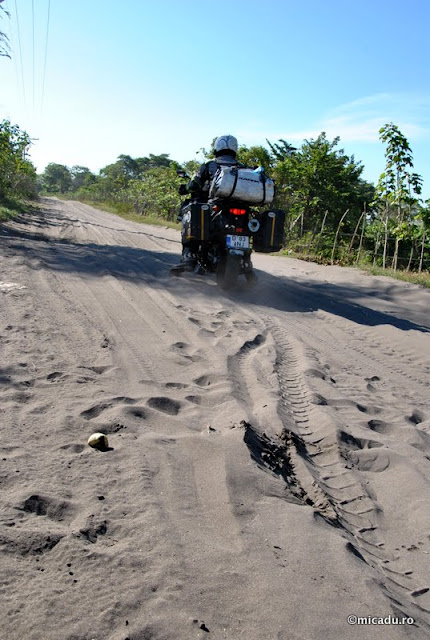
And get to a place… looking right out of an exotic postcard. Few huts built on wooden pillons, close to the beach, all facing the ocean (ours will be the first one on the right).

Reed roofs, hammocks by the beach. Great waves, deserted beach.
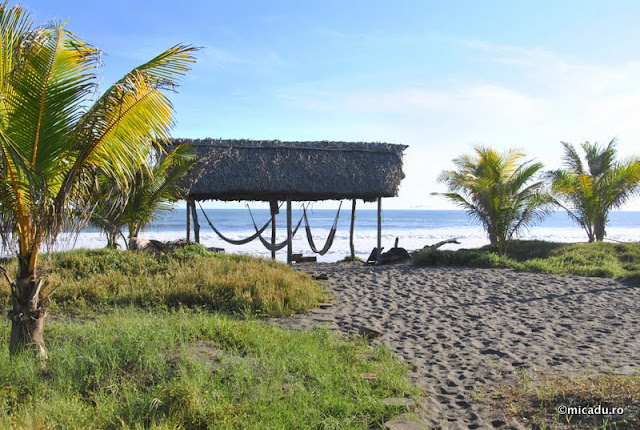
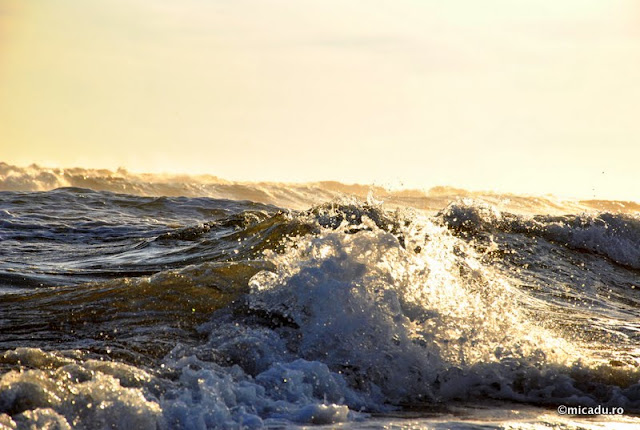

It’s great. For the following week we were to stay close to the ocean, moving one time from these hammocks to other ones few kilometers South East, in Monterrico. We were planning to cross into El Salvador in a few days. But for now… we are trapped on the beaches with volcanic sand, where crabs and turtles walk freely and sunsets are spectacular each time. There couldn’t have been a better way to say “goodbye” to Guatemala. Time stood still with us….
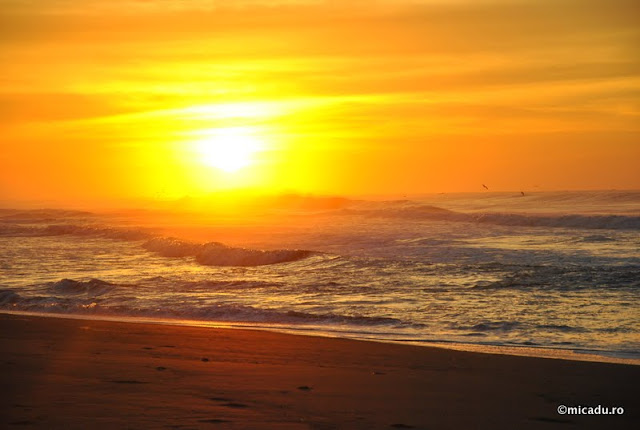



Route map for this story:
View Larger Map
Next time we find the courage to leave Guatemala and we press onwards to explore El Salvador and Honduras. Stay tunned!
|

29 Nov 2012
|
|
Registered Users
Veteran HUBBer
|
|
Join Date: Dec 2009
Location: Bucharest
Posts: 118
|
|
El Salvador: 13-16 November
We wake up very early. Mainly because we want to be few steps ahead of the heat…. once it gets hotter we might delay again our departure with “just one more day” and go back in the hammocks. We even have a theory about it. Many of the foreigners that now have businesses here by the beach, were at the beginning tourists like us, just visiting. Then they stayed “just one more day” until they became… locals. As for us… we still have a long way to go to reach Argentina so we don’t give in! It’s 7 AM and we are outside our room with luggage and everything. It’s already hot!!! On the hallway, our neighbor looks at us motionless, as if he is feeling sorry for us that we will get into the sun soon.
We are not feeling sorry for leaving him there,o n the wall and we speed up the process of loading everything on the motorcycle. Everybody is still sleeping at the hostel so there is not much people to say “goodbye” to. Only the owner’s parrot who keeps telling us “Ola! Ola!”. Our wheels don’t spin too much, if we want to cross into El Salvador we have to take a ferry that will take us 30 kilometers up the river where we can meet the road again. So we are arriving at the “deck”. But we don’t see any ferry. We are trying to ask around, what is the procedure, is there a schedule, when is the next ferry and how much is a ticket, these kind of small details. It’s all quiet on the bank. “What ferry… this is the ferry, this boat” answers one of the boys there pulling to the shore a wooden raft… Hmmm, should we get on or not? The only alternative is more than 100 kilometers detour and we want to get to El Salvador today. Then let’s get on! Meanwhile our man goes to bring the engine that was supposed to push us up the river. The wooden boat moves heavily leaving behind the village that’s slowly waking up. We had some more kilometers to go until the border but we feel like this is the place where we are saying “Goodbye” to Guatemala, here on a wooden raft, floating among the mangroves…. On the stills waters the locals are out fishing and the volcano outlines itself in the background. Goodbye Guatemala! Thank you for all you’ve offered us, thank you for your lessons! Hmm, once we get off the boat we feel like we are in another country although there are few more kilometers to the border. We can tell that the border is close when we start passing trucks. A lot of trucks parked on both sides of the road (yes, everybody was driving on the opposite side of the road). And when we get there… the whole place is packed. And still this is not the main border crossing, the PanaAmerican one. Central America is famous for the border crossing bureaucracy. We think this statement is unfair.We agree, it is not a regular border crossing, like crossing 2 E.U. countries. OK, sometimes time passes by differently when waiting here and it is sometimes hard to find the logic of certain actions.
The bureaucracy at the frontiers of Central America is the famous. We could say that this reputation is unjustly gained. Yes, it is not an usual crossing, as between 2 countries of European Union. OK, time flows differently in these borders and it is quite difficult to find the logic behind some of the actions you have to take there. Even between the same 2 countries, if you use different border crossings, things that have to be done and the order in which they have to be done can differ radically. However, with a little patience and kindness we have managed up to now to cross without problems and without “helpers” (people who make a living by acting as guides for foreigners at the borders). We hope that from now on to be the same. But, this border was much more agitated and, inevitably, I found odd things. For example the office where motor vehicles need to be “de-registered” out of the country is located… on the “incoming” side of the Border buildings (where vehicles go in the country) And there was no sign to indicate that. Therefore one has to walk around a bit until things are revealed  Our motorcycle jackets have a lot of flows and shortcomings but at least, nobody can say that they don’t have the hi-reflecting strips working properly. Then, of course that you will need to copy all kinds of documents so you better find “that” copy machine near the border (preferably one that is working and has also someone to work it – don’t ask….) With the formalities on the Guatemalan side over, we hop on the bike and head down the road to the El Salvador’s border navigating between tons of trucks. In the below picture, you can notice that we “upgraded” from driving in the opposing traffic lane to driving on the opposite side’s shoulder, on the far side of the road… and that is because the opposing traffic lane was already “occupied” as well by trucks. Fun!! Then another hour or so of paperwork and ta daaaa! we are in El Salvador! So here we roll, on the roads of a new country from Central America, the smallest country in fact, but the most densely populated. We try to stay away from the crowds and pick a road that goes near the coast. Before getting in El Salvador, I didn’t know much about this country. With a history as cloudy and intense as pretty much all other countries in the area, it is only in recent years that tourism started to take off with all that is implied by this. And if in the `90 more than 90% of forests area was deforested, after 2000 it has been reported a 20% increase in the forested area (how many countries in the world can brag with an increase in the woodland areas? ). We stop, purely at random, in one of the small surfing spots on the Pacific coast. We will stay here for a few days, relaxing and trying to surf as well. El Salvador will be good to us… Unfortunately I didn’t do that well on the surf board, being for the first time on it. But let me tell you, the few seconds that I was able to stand on my feet on the board, boy those were awesome! Well, after the “heroic” tries, I’ve settled on the beach, watching others do it properly..  And because surely you need a picture with girls in swim suits in order to have a successful ride report, here it goes!!! Well, joking aside, the life at the ocean’s shore was slaw and relaxing, with long hot days and evening full of magic. But after 3 days it was time to move, yet again, and start the next chapter of our journey.
But in order to reach that, we first needed to pass through San Salvador, country’s capital. Having no GPS and entering the concrete jungle we surely enough get lost pretty soon. At a stop light we ask some people in a car next to us for directions. The driver pulls to the right, get’s out of the car, shakes our hands, asks where are we coming from and where are we going and so on. We feel like some important guests, not like some helpless lost travelers…. Then the guy tells us to just follow his car, he will drive us to the correct exit of the town. Wow, really? I am sure he had other plans for that morning that didn’t include driving through rush hour just the help us but here we are… following a green BMW out of San Salvador So we exit the city in no time and after saying good bye to our new friends in the green BMW, we find ourselves on the road to the mountains. Beyond them, Honduras awaits. A new border crossing is in store for us, and after that a new country from Central America. I wonder how Honduras will be like? A lot of people just try to pass quickly from El Salvador to Nicaragua, spending just half a day in Honduras. We will try to explore for a few days, taking the long way through it. Map with the route from this post:
View Larger Map
Next time we meet Honduran roads and on them other travelers that are heading to South America. Stay tuned!
|
|
Currently Active Users Viewing This Thread: 1 (0 Registered Users and/or Members and 1 guests)
|
|
|
 Posting Rules
Posting Rules
|
You may not post new threads
You may not post replies
You may not post attachments
You may not edit your posts
HTML code is Off
|
|
|
|

Check the RAW segments; Grant, your HU host is on every month!
Episodes below to listen to while you, err, pretend to do something or other...

2020 Edition of Chris Scott's Adventure Motorcycling Handbook.
"Ultimate global guide for red-blooded bikers planning overseas exploration. Covers choice & preparation of best bike, shipping overseas, baggage design, riding techniques, travel health, visas, documentation, safety and useful addresses." Recommended. (Grant)

Led by special operations veterans, Stanford Medicine affiliated physicians, paramedics and other travel experts, Ripcord is perfect for adventure seekers, climbers, skiers, sports enthusiasts, hunters, international travelers, humanitarian efforts, expeditions and more.
Ripcord Rescue Travel Insurance™ combines into a single integrated program the best evacuation and rescue with the premier travel insurance coverages designed for adventurers and travel is covered on motorcycles of all sizes.
(ONLY US RESIDENTS and currently has a limit of 60 days.)
Ripcord Evacuation Insurance is available for ALL nationalities.
What others say about HU...
"This site is the BIBLE for international bike travelers." Greg, Australia
"Thank you! The web site, The travels, The insight, The inspiration, Everything, just thanks." Colin, UK
"My friend and I are planning a trip from Singapore to England... We found (the HU) site invaluable as an aid to planning and have based a lot of our purchases (bikes, riding gear, etc.) on what we have learned from this site." Phil, Australia
"I for one always had an adventurous spirit, but you and Susan lit the fire for my trip and I'll be forever grateful for what you two do to inspire others to just do it." Brent, USA
"Your website is a mecca of valuable information and the (video) series is informative, entertaining, and inspiring!" Jennifer, Canada
"Your worldwide organisation and events are the Go To places to for all serious touring and aspiring touring bikers." Trevor, South Africa
"This is the answer to all my questions." Haydn, Australia
"Keep going the excellent work you are doing for Horizons Unlimited - I love it!" Thomas, Germany
Lots more comments here!

Every book a diary
Every chapter a day
Every day a journey
Refreshingly honest and compelling tales: the hights and lows of a life on the road. Solo, unsupported, budget journeys of discovery.
Authentic, engaging and evocative travel memoirs, overland, around the world and through life.
All 8 books available from the author or as eBooks and audio books
Back Road Map Books and Backroad GPS Maps for all of Canada - a must have!
New to Horizons Unlimited?
New to motorcycle travelling? New to the HU site? Confused? Too many options? It's really very simple - just 4 easy steps!
Horizons Unlimited was founded in 1997 by Grant and Susan Johnson following their journey around the world on a BMW R80G/S.
 Read more about Grant & Susan's story
Read more about Grant & Susan's story
Membership - help keep us going!
Horizons Unlimited is not a big multi-national company, just two people who love motorcycle travel and have grown what started as a hobby in 1997 into a full time job (usually 8-10 hours per day and 7 days a week) and a labour of love. To keep it going and a roof over our heads, we run events all over the world with the help of volunteers; we sell inspirational and informative DVDs; we have a few selected advertisers; and we make a small amount from memberships.
You don't have to be a Member to come to an HU meeting, access the website, or ask questions on the HUBB. What you get for your membership contribution is our sincere gratitude, good karma and knowing that you're helping to keep the motorcycle travel dream alive. Contributing Members and Gold Members do get additional features on the HUBB. Here's a list of all the Member benefits on the HUBB.
|
|
|















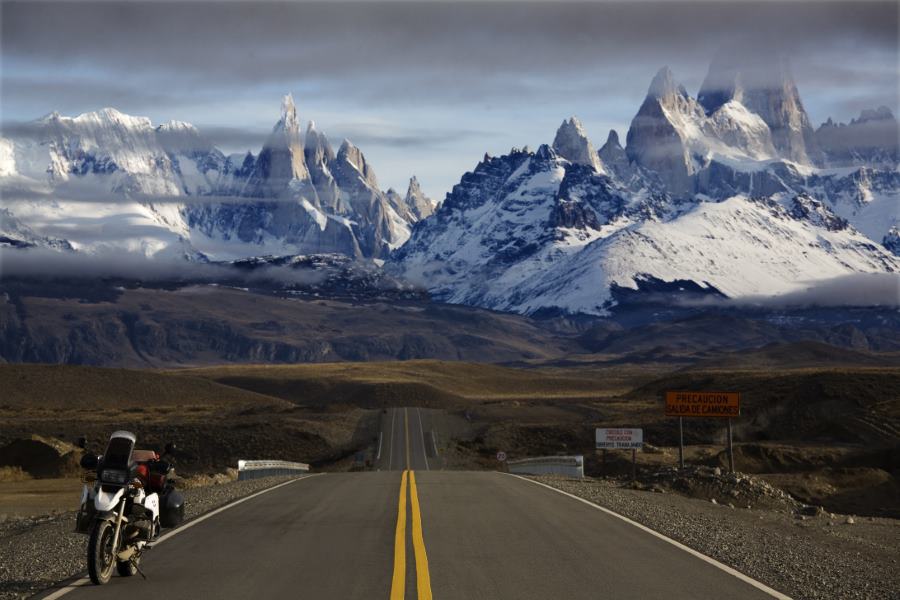

 8Likes
8Likes










 !
!





 Linear Mode
Linear Mode










